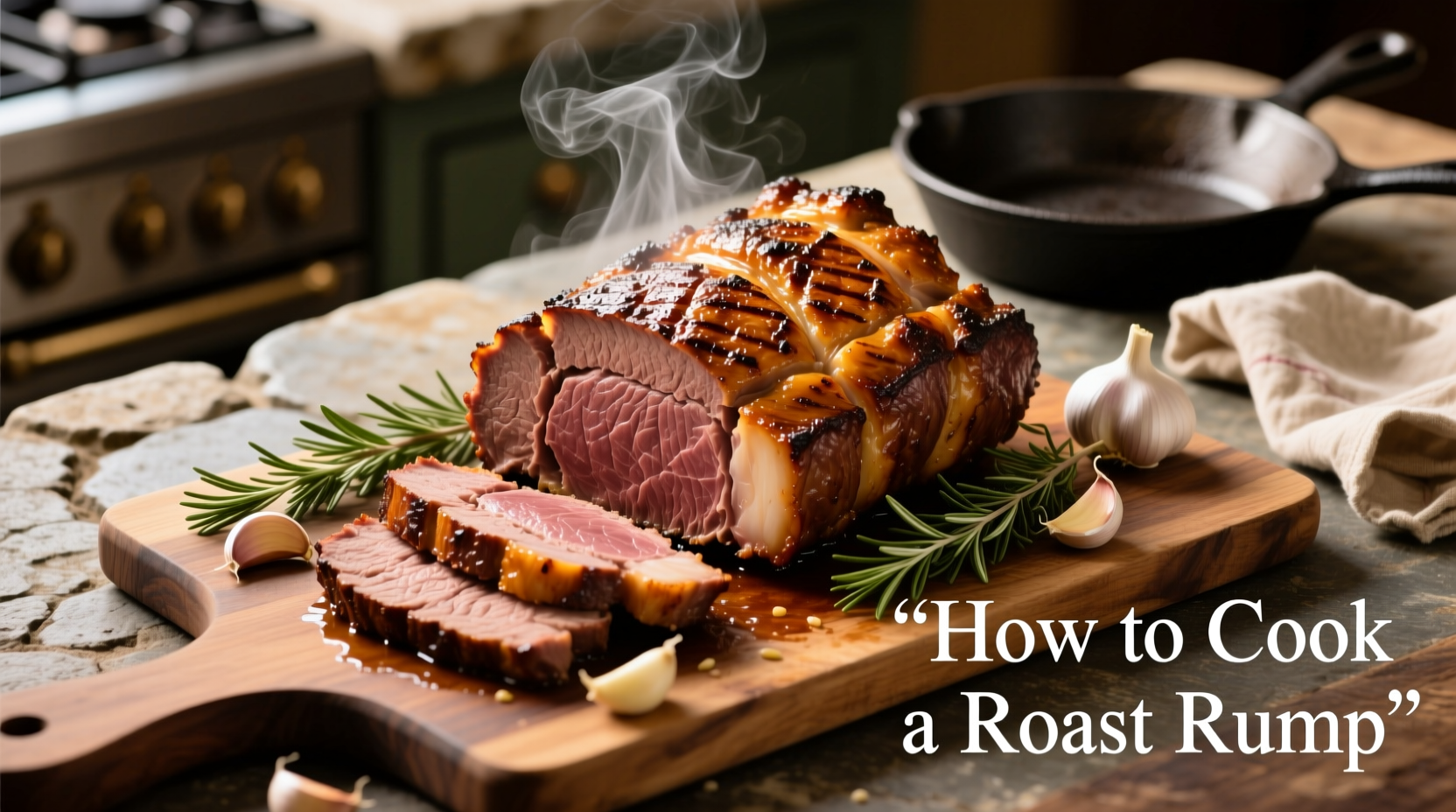Mastering how to cook a roast rump transforms this often-overlooked cut into a show-stopping centerpiece. Unlike premium cuts like ribeye, rump roast requires specific techniques to overcome its dense muscle structure while preserving its rich, beefy flavor profile. This comprehensive guide delivers restaurant-quality results through precise temperature control, strategic resting, and proper carving—no special equipment needed.
Understanding Rump Roast: The Underrated Champion
Rump roast, carved from the hindquarters of the animal, contains substantial connective tissue that demands careful cooking. This cut's reputation for toughness stems from improper preparation rather than inherent flaws. When handled correctly, it delivers exceptional depth of flavor at a fraction of the cost of premium roasts.
| Cut | Location | Texture Profile | Best Cooking Method |
|---|---|---|---|
| Rump Roast | Hindquarter | Dense, muscular | Slow roasting with precise temp control |
| Chuck Roast | Shoulder | Marbled, connective tissue | Braising |
| Top Sirloin | Upper hip | Moderately tender | High-heat searing + moderate roasting |
This comparison reveals why how to properly cook rump roast differs from other popular cuts. Its location in the well-exercised hindquarter creates a denser muscle structure requiring specialized handling.
Evolution of Rump Roast Preparation
Historically considered a tough cut suitable only for slow cooking, modern culinary science has transformed rump roast preparation. The USDA's temperature guidelines evolution demonstrates this shift:
- 1950s-1980s: Cooked to well-done (160°F+) resulting in dry, tough meat
- 1990s: Introduction of medium (140°F) standards with limited adoption
- 2006: USDA officially recognizes medium-rare (130-135°F) as safe for whole cuts
- Present: Precision cooking at 130-135°F with mandatory resting period
This progression in best practices for cooking rump roast reflects improved understanding of meat science and food safety standards. The current approach maximizes tenderness while ensuring safety.
Preparation: Setting Up for Success
Proper preparation makes the difference between chewy and chef-worthy results:
- Selection: Choose well-marbled roasts (1.5-3 lbs) with bright red color and firm texture
- Temperature Equilibrium: Remove from refrigerator 2 hours before cooking to reach room temperature
- Dry Brining: Salt generously 12-24 hours in advance to enhance flavor and moisture retention
- Seasoning: Apply oil-based rub (olive oil, garlic powder, rosemary) 30 minutes before cooking
This preparation sequence for how to cook roast beef rump creates optimal conditions for surface browning while maintaining interior moisture.
Cooking Process: Precision Temperature Control
Follow this foolproof method for perfect results every time:
- Preheat oven to 325°F (163°C) - lower temperature prevents exterior overcooking
- Place roast on rack in roasting pan, fat side up
- Insert meat thermometer into thickest part
- Cook until internal temperature reaches 120-125°F (49-52°C) for medium-rare
- Estimated cooking time: 18-22 minutes per pound
| Doneness | Internal Temp | Resting Temp | Total Time (3lb roast) |
|---|---|---|---|
| Medium-Rare | 120-125°F | 130-135°F | 1h 45m-2h 15m |
| Medium | 125-130°F | 135-140°F | 2h-2h 30m |
| Medium-Well | 135-140°F | 145-150°F | 2h 15m-2h 45m |
These precise temperature targets for cooking times for rump roast account for the critical carryover cooking that occurs during resting. Never skip the thermometer—it's essential for perfect results.
The Critical Resting Phase
Resting isn't optional—it's the secret to juicy results. During this period:
- Loosely tent with foil to maintain warmth without steaming
- Place on cutting board with groove to catch juices
- Allow minimum 20 minutes for 3-4 lb roasts (15 minutes per pound)
- Temperature will rise 5-10°F during this phase
This resting technique for how to cook rump roast beef allows muscle fibers to reabsorb juices, preventing dryness when sliced. Cutting too soon releases precious moisture onto the cutting board.
Carving and Serving: The Final Touch
Proper carving makes or breaks your efforts:
- Identify the direction of muscle fibers (they run lengthwise)
- Use sharp carving knife with smooth slicing motion
- Cut perpendicular to fibers in ¼-inch slices
- Serve immediately with collected pan juices
For the best presentation of how to slice rump roast, arrange slices slightly overlapping on a warmed platter. The thin slices showcase the perfect pink interior while maintaining structural integrity.

Troubleshooting Common Issues
Even experienced cooks encounter challenges with this cut. Here's how to fix them:
- Dry Results: Usually caused by overcooking or insufficient resting. Solution: Cook to lower temperature target and extend resting time.
- Tough Texture: Indicates under-resting or improper slicing. Solution: Rest longer and ensure you're cutting against the grain.
- Pale Exterior: Oven temperature too low or insufficient surface drying. Solution: Increase oven temp by 25°F or extend initial high-heat sear.
- Uneven Cooking: Roast not at room temperature. Solution: Always allow adequate time for temperature equilibrium before cooking.
These solutions for common rump roast problems address the most frequent issues home cooks face, transforming potential disasters into triumphs.
Proven Serving Combinations
Enhance your roast rump beef recipe with these classic pairings:
- Yorkshire Puddings: Traditional accompaniment that soaks up flavorful juices
- Roasted Root Vegetables: Carrots, parsnips, and potatoes roasted alongside the meat
- Red Wine Jus: Pan drippings deglazed with quality red wine and beef stock
- Horseradish Cream: Provides bright contrast to the rich meat
Leftover rump roast shines in sandwiches, salads, or thinly sliced for stir-fries—never waste this flavorful cut.











 浙公网安备
33010002000092号
浙公网安备
33010002000092号 浙B2-20120091-4
浙B2-20120091-4